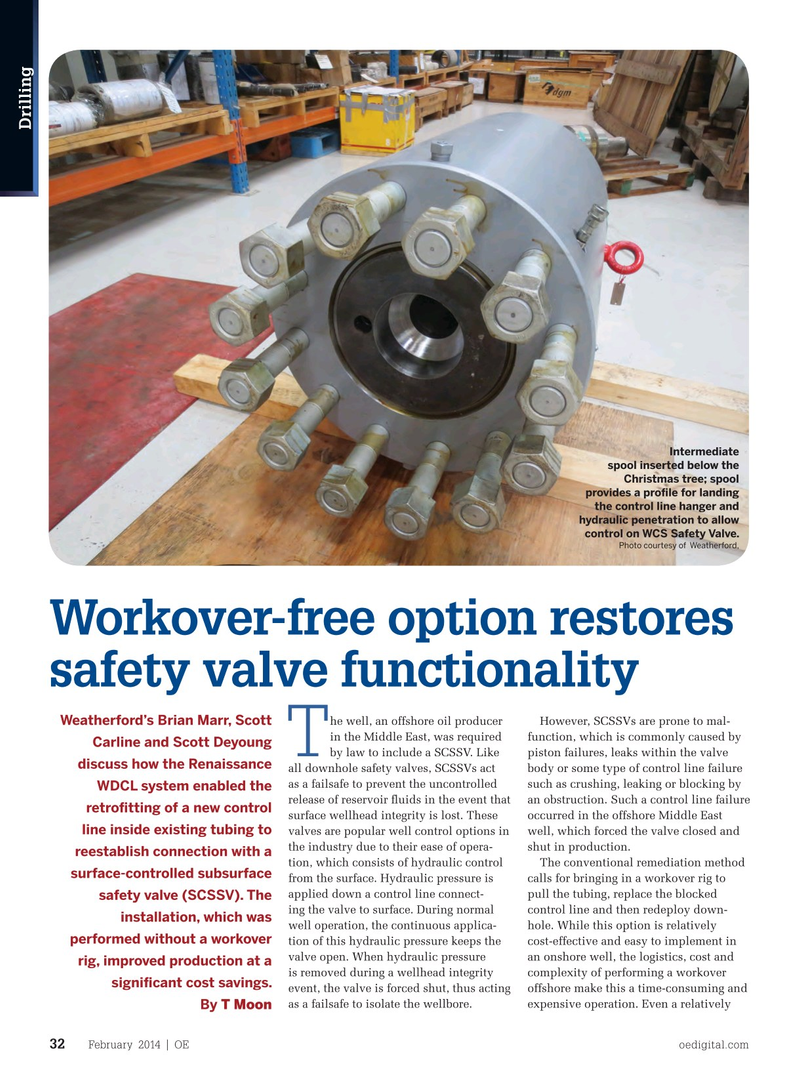
Page 30: of Offshore Engineer Magazine (Feb/Mar 2014)
Read this page in Pdf, Flash or Html5 edition of Feb/Mar 2014 Offshore Engineer Magazine
simple workover of an offshore well in the Middle East might cost upwards of
US$6 million, according to estimates from the operator.
Weatherford collaborated with the
Drilling operator to develop an alternative pro- cess—an intervention that would restore functionality to the SCSSV by retroftting a new control line and inserting a new valve within the existing well architec- ture. The operator required the interven- tion to be performed without killing the well, pulling the tubing or incurring the time delays and costs that commonly come with a major workover.
A Renaissance in well revival
Upon review of the well parameters and intervention requirements, the operator decided to deploy Weatherford’s
Renaissance WDCL system, a wireline- retreivable subsurface safety valve that allows both the control line and the safety valve to be replaced in a straight- forward retroft procedure.
Intermediate
The system has a modifed pack- spool inserted below the ing mandrel and wet connection, and
Christmas tree; spool a valve-and-lock assembly that can be provides a profle for landing installed in an existing tubing-mounted the control line hanger and safety valve or safety-valve landing nip- hydraulic penetration to allow ple. A capillary line is then run from the control on WCS Safety Valve.
Photo courtesy of Weatherford, surface inside the tubing and connected to the valve to provide control.
The retroft process for this offshore well was performed from a jackup rig, and began by modifying the wellhead to provide the correct profle for the capil-
Workover-free option restores lary hanger and gain access for the new capillary control line. A wireline crew safety valve functionality he well, an offshore oil producer However, SCSSVs are prone to mal-
Weatherford’s Brian Marr, Scott function, which is commonly caused by in the Middle East, was required
Carline and Scott Deyoung
T piston failures, leaks within the valve by law to include a SCSSV. Like discuss how the Renaissance body or some type of control line failure all downhole safety valves, SCSSVs act such as crushing, leaking or blocking by as a failsafe to prevent the uncontrolled
WDCL system enabled the an obstruction. Such a control line failure release of reservoir fuids in the event that retroftting of a new control occurred in the offshore Middle East surface wellhead integrity is lost. These line inside existing tubing to valves are popular well control options in well, which forced the valve closed and shut in production. the industry due to their ease of opera- reestablish connection with a tion, which consists of hydraulic control
The conventional remediation method surface-controlled subsurface calls for bringing in a workover rig to from the surface. Hydraulic pressure is applied down a control line connect- pull the tubing, replace the blocked safety valve (SCSSV). The control line and then redeploy down- ing the valve to surface. During normal installation, which was well operation, the continuous applica- hole. While this option is relatively performed without a workover tion of this hydraulic pressure keeps the cost-effective and easy to implement in valve open. When hydraulic pressure an onshore well, the logistics, cost and rig, improved production at a complexity of performing a workover is removed during a wellhead integrity signifcant cost savings. event, the valve is forced shut, thus acting offshore make this a time-consuming and as a failsafe to isolate the wellbore.
expensive operation. Even a relatively
By T Moon
February 2014 | OE oedigital.com 32 032_OE0214_DC1.indd 32 1/20/14 11:53 PM

 29
29

 31
31